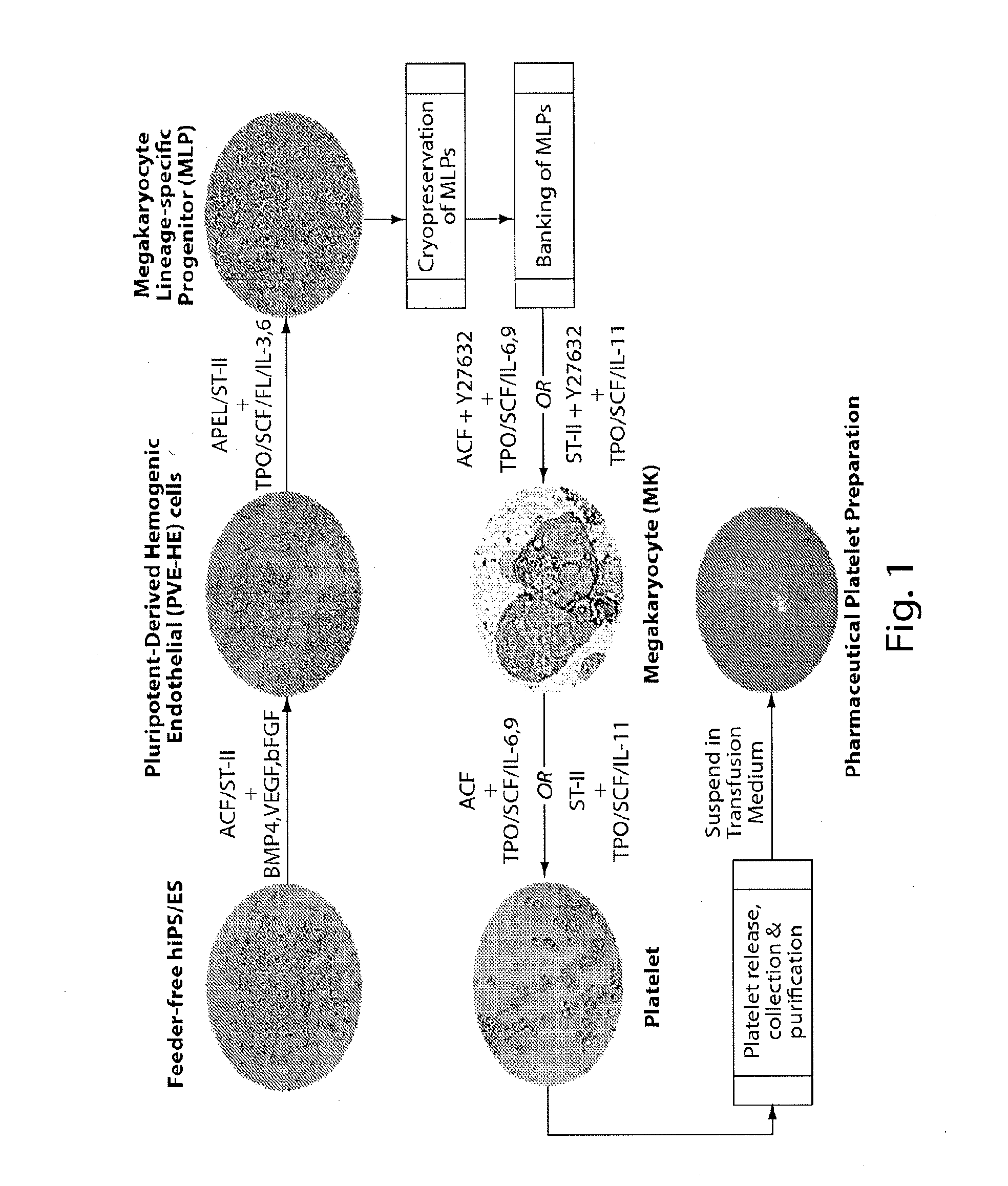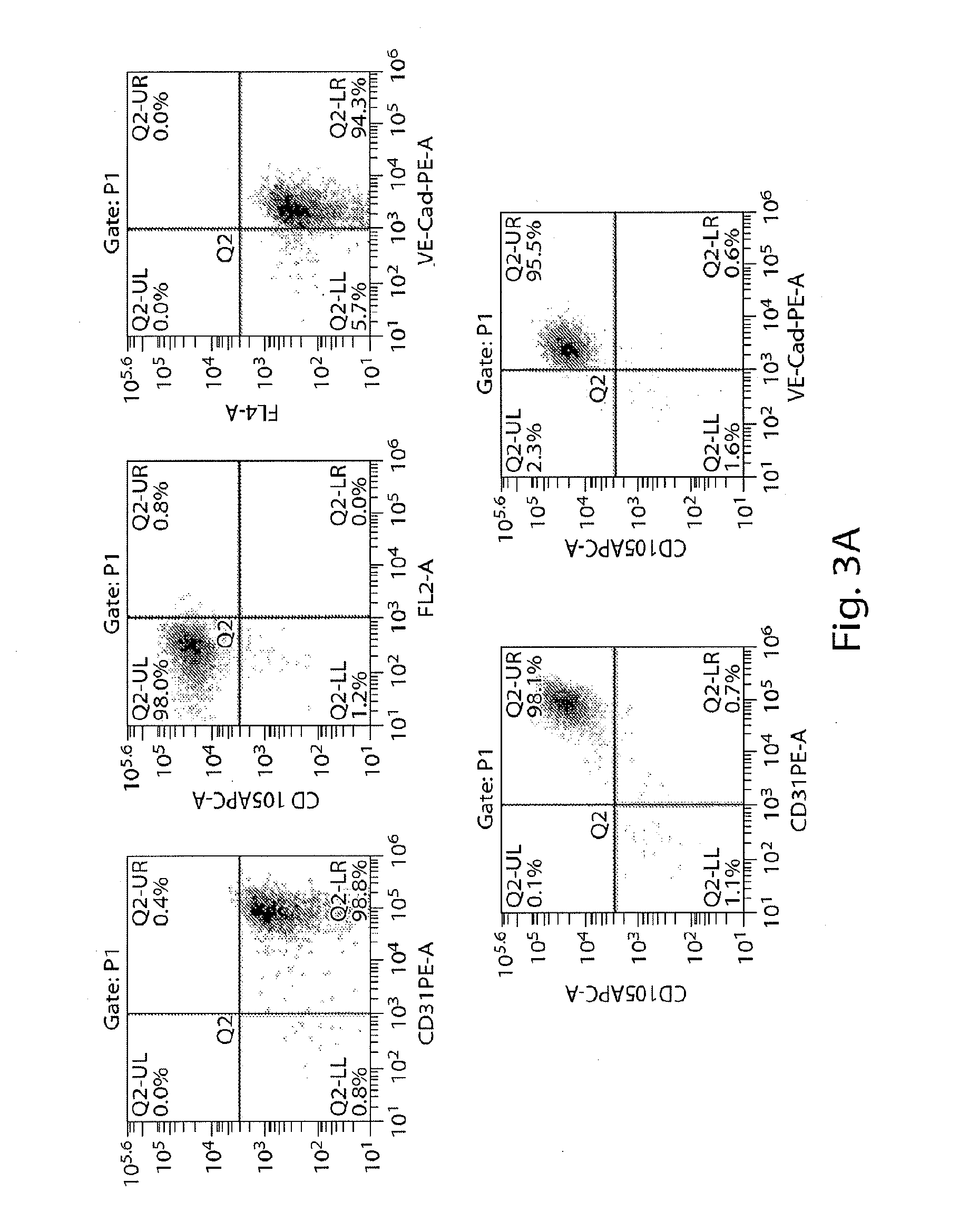Methods for production of platelets from pluripotent stem cells and compositions thereof
a technology of pluripotent stem cells and platelets, which is applied in the direction of drug compositions, antiparasitic agents, extracellular fluid disorder, etc., can solve the problems of very limited shelf life of platelets collected from donors, achieve greater yield and/or purity, and eliminate contaminating nucleated cells. , the effect of reducing the number of contaminated cells
- Summary
- Abstract
- Description
- Claims
- Application Information
AI Technical Summary
Benefits of technology
Problems solved by technology
Method used
Image
Examples
example 1
Generation of Pluripotent-Derived Hemogenic Endothelial Cells (PVE-HE)
[0385]Pluripotent-Derived Hemogenic Endothelial Cells (PVE-HE) were generated from induced pluripotent stem (iPS) cells.
[0386]First, iPS cells were expanded by culturing on Matrigel (a soluble preparation from Engelbreth-Holm-Swarm (EHS) mouse sarcoma cells) in the feeder-free pluripotent stem cell culture medium mTeSR1. Briefly, human iPS cells were harvested by dissociation using chemically defined Cell Dissociate Buffer (CDB) with EDTA as the sole active component. No enzyme or any other animal products were used in the culture medium or CDB. For investigators with ordinary skill in the art, it should be understood that it is possible to use another chemically defined matrix such as recombinant vitronectin or SyntheMax II, or medium such as mTeSR2, or other compatible cell dissociation reagents.
[0387]Second, harvested human iPS cells were prepared for differentiation into multipotent PVE-HE which were PECAM1+VE...
example 2
Generating Detached Megakaryocytic Lineage-Specific Progenitors (MLPs) from Human iPS-Derived PVE-HE Cells
[0390]First, initiation of MLP differentiation was performed 120 hours after initiating PVE-HE differentiation. Briefly, DIM medium containing 50 ng / ml BMP4, 50 ng / ml bFGF, and 50 ng / ml VEGF was removed and replaced with MLP Derivation and Expansion medium (MLP-DEM, also referred to as APEL or Stemline II, as shown in FIG. 1) comprised of Iscove's modified Dulbecco's medium (IMDM), Ham's F-12 nutrient mixture, Albucult (rh Albumin), Polyvinylalcohol (PVA), Linoleic acid, SyntheChol (synthetic cholesterol), Monothioglycerol (a-MTG), rh Insulin-transferrin-selenium-ethanolamine solution, protein-free hybridoma mixture II (PFHMII), ascorbic acid 2 phosphate, Glutamax I (L-alanyl-L-glutamine), Penicillin / streptomycin, Stem Cell Factor (SCF) at 25 ng / ml, Thrombopoietin (TPO) at 25 ng / ml, Fms-related tyrosine kinase 3 ligand (FL) at 25 ng / ml, Interleukin-3 (IL-3) at 10 ng / ml, Interleu...
example 3
Generating Mature Platelets from Human iPS-PVE-HE-MLP-Derived Megakaryocytes (MK)
[0394]First, initiation of platelet differentiation was performed using human iPS-PVE-HE-derived MLP cells, as described above. MLPs were seeded onto a non-adherent surface in MK media (MK-M) comprised of Iscove's Modified Dulbecco's Medium (IMDM) as basal medium, human serum albumin, iron-saturated transferrin, insulin, b-mercaptoethanol, soluble low-density lipoprotein (LDL), cholesterol, TPO at 30 ng / ml, SCF at 1 ng / ml, IL-6 at 7.5 ng / ml, IL-9 at 13.5 ng / ml, Y27632 at 5 μM, and Heparin at 5-25 units / ml. Cells were then incubated at 37° C. in 5% CO2 for 3 days.
[0395]In some instances, the MLPs were seeded onto a non-adherent surface in culture medium comprised of Iscove's modified Dulbecco's medium (IMDM), Ham's F-12 nutrient mixture, Albucult (rh Albumin), Polyvinylalcohol (PVA), Linoleic acid, Linolenic acid, SyntheChol (synthetic cholesterol), Monothioglycerol (a-MTG), rh Insulin-transferrin-seleni...
PUM
| Property | Measurement | Unit |
|---|---|---|
| volume distribution | aaaaa | aaaaa |
| volume distribution | aaaaa | aaaaa |
| volume distribution | aaaaa | aaaaa |
Abstract
Description
Claims
Application Information
 Login to View More
Login to View More - R&D
- Intellectual Property
- Life Sciences
- Materials
- Tech Scout
- Unparalleled Data Quality
- Higher Quality Content
- 60% Fewer Hallucinations
Browse by: Latest US Patents, China's latest patents, Technical Efficacy Thesaurus, Application Domain, Technology Topic, Popular Technical Reports.
© 2025 PatSnap. All rights reserved.Legal|Privacy policy|Modern Slavery Act Transparency Statement|Sitemap|About US| Contact US: help@patsnap.com



